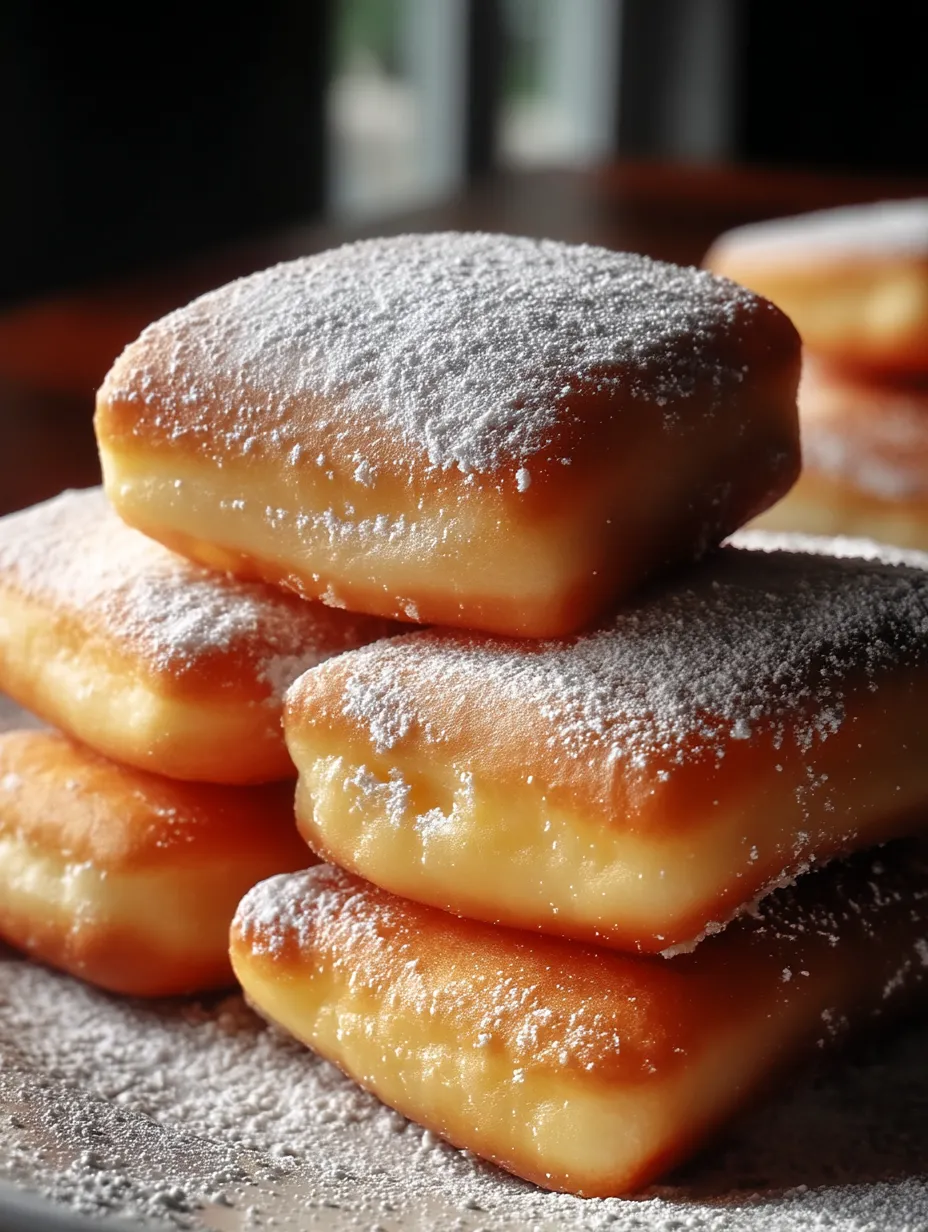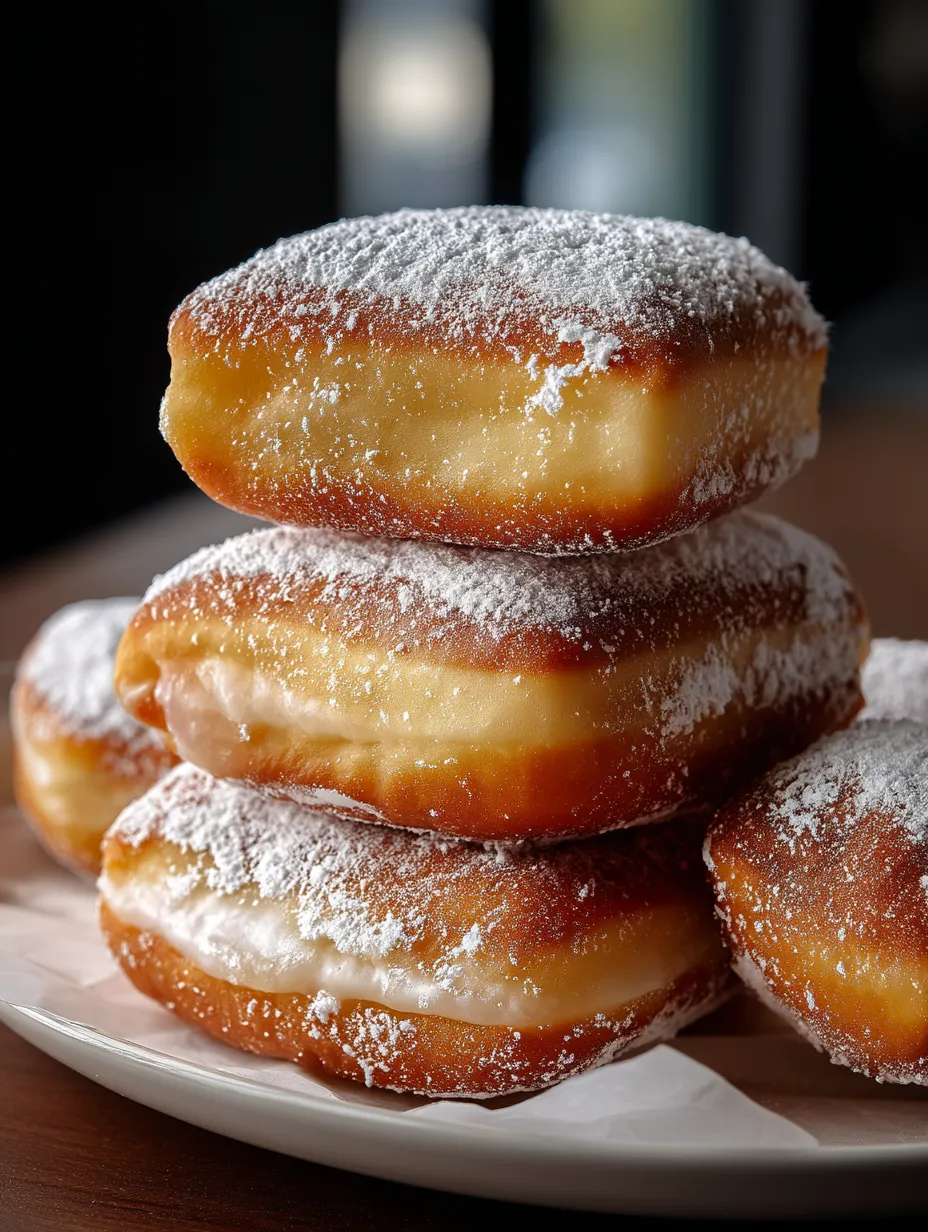 Pin it
Pin it
These cloud-like vanilla French beignets bring pure food joy with every golden, sugar-covered bite. What makes them special? A gently sweetened yeast dough packed with aromatic vanilla that turns into stunning pastries with crisp outsides and fluffy insides. Unlike heavy sweets, these beignets stay wonderfully light so you can enjoy their subtle sweetness without feeling stuffed. They're perfect with morning joe, afternoon tea, or as a fancy dessert with fresh fruit. These French-style treats turn regular moments into something special without much work but with tons of wow factor.
The first time I whipped up these beignets for my family get-together, I couldn't believe how fast they vanished. My typically quiet brother-in-law gobbled up four in a row then shyly asked if I had any more tucked away. Even my cousin who's a professional pastry chef wanted my recipe, saying they were as good as what she'd eaten in Paris. What I really love about them is how flexible they are – they're fantastic just dusted with powdered sugar, but pair them with some fresh berries and whipped cream and you've got a show-stopping dessert.
Ideal Components
- 3½ cups all-purpose flour: Gives these airy treats their perfect structure
- ¼ cup granulated sugar: Adds just enough sweetness to match the vanilla flavor
- 1 teaspoon active dry yeast: The key to getting that famous puffy texture
- 1 cup warm milk: Wakes up the yeast and keeps everything soft
- 2 large eggs: Brings richness and helps build the dough framework
Your choice of vanilla really matters in these beignets. Go for real vanilla extract instead of the fake stuff for a much better flavor. Also, make sure your yeast is fresh and active or you won't get that lovely rise and texture. For flour, grab unbleached all-purpose for the best results – it'll give your beignets just enough body while keeping them tender.
Step-by-Step Process
- Waking Up The Yeast:
- Start by heating one cup of milk to about 110°F (43°C) – this temp is super important since it gets the yeast going without killing it. The milk should feel warm on your wrist, not hot. Mix the warm milk with one teaspoon of active dry yeast and a tiny bit of sugar in a small bowl to feed the yeast. Stir it gently until everything dissolves, then let it sit in a warm spot for 5-10 minutes. You should see foam form on top, which means your yeast is alive and happy. If nothing happens, your yeast might be too old or your milk was too hot, so you'll need to start over.
- Making The Dough:
- In a big bowl, mix three and a half cups of all-purpose flour, one-quarter cup of sugar, and one teaspoon of salt until they're all combined. Create a hole in the middle, then pour in your foamy yeast mixture, two slightly beaten eggs, one teaspoon of vanilla extract, and one-quarter cup of melted butter that's cooled a bit. Use a wooden spoon to slowly mix everything together, starting from the middle and working outward. When it looks shaggy, dump it onto a lightly floured counter. Knead the dough with clean hands for 5-8 minutes until it feels smooth and stretchy, a bit tacky but not sticky. The right kneading method is pushing the dough away with your palm, folding it back over, turning it a quarter turn, and doing it again. This builds up the gluten that gives beignets their special texture.
- Letting It Grow:
- Lightly oil a clean, big bowl and put your kneaded dough in it, turning once so oil coats both sides. Cover the bowl with a kitchen towel or plastic wrap and put it somewhere warm with no drafts. Around 75-80°F (24-27°C) is perfect – near a warm oven or in an oven that's off but with just the light on works great. Let the dough rise until it's doubled in size, usually about an hour. This rising time is crucial for getting that light, airy texture that makes beignets so amazing. You'll know it's ready when you can press two fingers about half an inch into the dough and the dent stays put instead of bouncing back right away. That shows the yeast has made enough bubbles to properly puff up the dough.
- Forming The Pastries:
- After the dough has doubled, gently punch it down to release extra air bubbles. Turn it out onto a lightly floured surface and roll it into a rectangle about half an inch thick with a rolling pin. Try to keep the thickness even so they'll cook the same. Using a sharp knife or pizza cutter, cut the dough into 2-3 inch squares. Don't twist or pull as you cut – clean cuts help keep the dough fluffy. For traditional New Orleans-style, you can cut diamond shapes instead. Cover the cut pieces loosely with a clean kitchen towel and let them rest for 15-20 minutes while you get the frying oil ready. This short second rise gives the yeast one last chance to create perfectly light texture.
- Frying To Perfection:
- Pour vegetable oil about 2 inches deep in a heavy Dutch oven or deep skillet and heat it to 350°F (175°C). A candy or deep-fry thermometer really helps here – the right temperature is crucial. Too cold and the beignets soak up too much oil; too hot and they brown before cooking inside. Work with small batches of 3-4 beignets at a time so you don't crowd the pan or cool the oil too much. Carefully drop the dough squares into the hot oil. They should start puffing up and floating right away. Cook about 2-3 minutes per side, using a slotted spoon to flip them when the bottom turns golden brown. Once both sides are evenly golden and puffed up nicely, take them out and put them on paper towels to drain extra oil. Check your oil temperature between batches and adjust the heat to keep it at 350°F for the best results.
 Pin it
Pin it
I've tried loads of beignet recipes over the years, but this vanilla version has become my go-to for special brunches and family parties. My big breakthrough was letting the cut dough rest before frying – it makes them incredibly light. My grandma, who hardly ever complimented anyone's cooking, called these "better than any donut" – which coming from her was practically a five-star review!
Ways To Enjoy
Turn these golden puffs into an unforgettable food experience by thinking about how to present them. For a fancy breakfast spread, make a beignet board by placing freshly fried treats on a wooden platter with little bowls of seasonal berries, whipped honey butter, and chocolate spread so everyone can customize their own. When you have friends over in the afternoon, pair beignets with different drinks – strong espresso gives a bitter contrast that makes the sweetness pop, while bubbly Prosecco offers a refreshing fizz against the rich pastry. For special events, try stacking them in a pyramid, sprinkling powdered sugar at the table, and surrounding them with edible flowers for a centerpiece you can eat!
Tasty Twists
Try these tasty changes to the basic recipe while keeping that wonderful light texture. For a fancy twist, mix in two teaspoons of orange or lemon zest to the dough and finish with citrus-flavored powdered sugar by blending dried citrus zest with confectioners' sugar in a food processor. Chocolate lovers can add two tablespoons of cocoa powder to the dry ingredients, then serve the chocolate beignets with raspberry sauce for an amazing flavor combo. In fall, try adding one teaspoon of pumpkin pie spice to the dough and serve with maple-sweetened whipped cream. For parties, stuff your beignets by putting a teaspoon of good jam or chocolate spread in the middle of each dough square before folding and sealing the edges before frying – it's a lovely surprise when you bite in.
Prep Ahead Tricks
Enjoy fresh beignets without last-minute stress by planning ahead. You can make the dough up to 24 hours early and keep it in the fridge after the first rise – just push down the risen dough, wrap it tight in plastic, and refrigerate. When you're ready, let the cold dough sit out for 30 minutes before rolling, cutting, and frying. For longer planning, freeze the unfried beignet squares by placing them in a single layer on a parchment-lined baking sheet until solid, then move them to freezer bags where they'll last up to a month. You can fry frozen beignets directly – just add about a minute to the cooking time per side. To make hosting easier, get all your ingredients and tools ready the night before, including measuring the flour and sugar, setting out the cooling rack, and prepping any extras, so you can focus on frying when your guests arrive.
Keeping Them Fresh
While these treats are definitely best fresh from the fryer, you can save any extras with the right approach. Let leftover beignets cool completely before storing in an airtight container at room temperature, where they'll stay good for up to two days. To bring day-old beignets back to life, heat your oven to 350°F (175°C), place them on a baking sheet, and warm for 3-5 minutes until heated through. Or try a few seconds in the microwave to soften them up, though they won't stay as crisp outside. For longer storage, fully cooled beignets can go in the freezer in sealed containers with parchment paper between layers for up to a month. Let frozen beignets thaw at room temperature for an hour, then warm using the oven method. Don't forget to add fresh powdered sugar right before serving, as the original coating will have soaked in during storage.
 Pin it
Pin it
The first time I brought these vanilla French beignets to a family brunch, everyone at our usually chatty table fell silent – that rare quiet moment when people are truly enjoying something amazing. What started as my attempt to recreate a pastry from my travels has become my signature dish that friends and family now ask for whenever we celebrate. There's something magical about watching basic ingredients turn into these golden pillows, and it's even better seeing how happy they make everyone. Whether dressed up with fancy toppings or simply enjoyed with coffee, these beignets somehow make ordinary days feel special.
Frequently Asked Questions
- → Can the dough be prepared ahead of time?
- Absolutely! Mix up the dough the day before and refrigerate it overnight. This slow rise enhances flavor. Cover it in a bowl and let it chill. The next day, let it sit at room temperature for 30 minutes before rolling out. You can also freeze cut, uncooked dough and fry straight from frozen after thawing in the fridge. Keeps for 3 months frozen.
- → Why are my beignets not light or fluffy?
- A few things might go wrong. Make sure your yeast is bubbly and active—foam it in warm milk with sugar beforehand. Knead the dough enough to feel stretchy but avoid overdoing it (5-8 minutes max). Allow it to fully double in size during rising. Lastly, check your frying temperature—it should hover between 350-360°F. Too cold and the dough gets greasy, too hot and they’ll burn before cooking through.
- → Can I bake these instead of frying?
- Sure! Baking gives a different texture but still works. Heat your oven to 400°F, place the dough squares on parchment, brush them with melted butter, and bake until lightly golden (10-12 minutes). They won’t puff the same but will taste sweet with powdered sugar on top.
- → What kind of oil works best for frying these?
- Pick oils with a mild taste and high heat tolerance. Vegetable, canola, or peanut oil are all good bets. Keep clear of olive oil since it burns easily and adds a flavor that doesn’t match the dessert. Maintain 350-360°F frying temp for even cooking!
- → How should I store and reheat extras?
- Leftovers stay okay for 1-2 days in an airtight container. Warm them up in a 350°F oven for a few minutes. Sprinkle on fresh powdered sugar if needed. Microwaving isn’t ideal as it makes them chewy. If you want the freshest flavor, fry just what you need and store uncooked dough instead.
